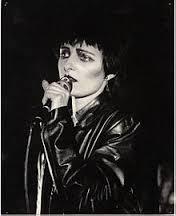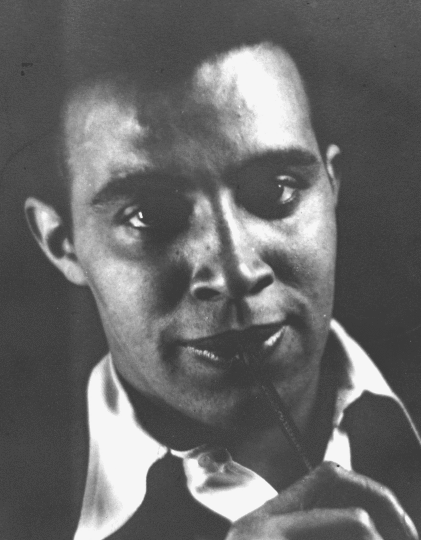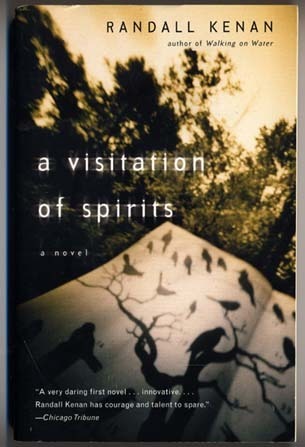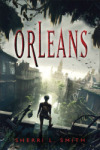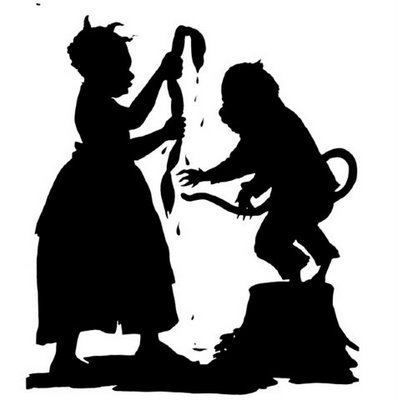Craig Laurance Gidney's Blog, page 60
June 10, 2013
FICTION: Join Hands by C.L. Gidney at Wattpad
I have a short piece of homoerotic fiction up at Wattpad. It was written for a cancelled anthology about queer punks. It’s set in London and features cameos by Siouxsie Sioux and Sid Vicious. Enjoy Join Hands


Beyond 'Game of Thrones': Exploring diversity in speculative fiction
 Reblogged from Hero Complex - movies, comics, pop culture - Los Angeles Times:
Reblogged from Hero Complex - movies, comics, pop culture - Los Angeles Times:




Last August, Weird Tales magazine, long a fixture on the speculative fiction landscape, got hit with a heavy dose of online fury.
The publication had made plans to publish an excerpt from an ecologically themed dystopian novel in which whites are the oppressed minority and their oppressors are referred to as “coals.”
Those who attacked the work were upset by a number of elements seen as racially problematic, up to and including the title, “Saving the Pearls,’’ “pearls” being the book’s term for white people and a word read as charged with an altogether different tenor than the notion of “coals.” In response to the outcry, the magazine pulled the excerpt.
A great article about Authors of Color who write Speculative Ficton!
June 9, 2013
Guest Review: The Chaos
 Reblogged from Crazy QuiltEdi:
Reblogged from Crazy QuiltEdi:
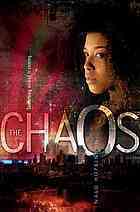
Title: The Chaos
Author: Nalo Hopkinson
Date: Margaret K. McElderry Books, 2012
Reviewer: Craig Laurance Gidney
In many ways, Sojourner “Scotch” is a typical teenager. She must navigate between her “good girl” persona when at home with her strict parents and her saucier persona at school, where she is a member of a hip hop dance crew. She has broken up with her boyfriend, and her (former) best friend is sniffing around him.
Here is my review of The Chaos, by Nalo Hopkinson, on Edi Campbell's blog.
June 7, 2013
Muses: The Wildean Aesthete of the Harlem Renaissance
My story “Conjuring Shadows” was inspired by the Harlem Renaissance writer and artist Richard Bruce Nugent. As a writer, Nugent’s work was strongly influenced by modernism. It was highly elliptical and poetic. His most famous piece, “Smoke, Lilies and Jade” is a stream of consciousness mediation on art, racial and sexual identity. “Smoke, Lilies and Jade” is also a pioneering work of black gay writing. Nugent was also a painter and illustrator. His illustration work has the sinister eroticism of Cocteau’s scribbles, and the wicked decadence of Aubrey Beardsley, while his paintings are influenced by the Romantics. Like Oscar Wilde, Nugent also penned retold Biblical tales and myths. Nugent was also born in Washington, DC, like yours truly.


June 4, 2013
Books I Wish I’d Written: The alchemical novel A Visitation of Spirits by Randall Kenan
Whatever happened to Randall Kenan?
If you like magical realism, you must read his first, and to my knowledge, only published novel, A Visitation of Spirits. The book follows a young closeted black nerd (comic books are his obsession) named Horace. He wants to transform into a bird to escape the religious, homophobic community where he lives. He believes that his desire is the result of demonic possession. The novel chronicles a season in hell, to borrow Rimbaud’s phrase. Keenan’s prose soars and he uses all manner of narrative techniques to convey Horace’s interior emotional landscape. It’s what I would call an alchemical novel, one that transcends the limitations of realistic fiction to reveal greater truths. A Visitation of Spirits is a masterpiece of magical realism and belongs on the same shelf as Toni Morrison and Ben Okri. It is also a seminal work about black gay lives. Anyone who loves lush, surreal language should hunt down a copy!
I wish Kenan would write another book!


June 2, 2013
May 30, 2013
Muses: Grace and Anger in Kara Walker’s work.
Black and white are the primary colors artist Kara Walker uses. Shadow and light. Negative and positive space. Her tableaux are made of black paper, and they are silhouetted against a gallery’s white walls The archetypical imagery she uses–sordid scenes from slavery. The wild-haired pickaninny, the scheming Southern Belle, the oblivious Good Master, the slave’s body in chains… Referents are classic children’s books, the mythology of the Antebellum South, and black memorabilia. It’s work that is never kitsch or twee; it’s dangerous and graceful at the same time.
Walker’s work dismantles the Master’s House with the master’s tool, to borrow a quote from Audre Lorde.


May 28, 2013
Golliwogs, Black Pete and screaming cakes: Linde and the African grotesque
Blackface, the act and art of caricaturing African skins and features, is a practice that won’t die. It lives on in the fashion industry and advertising, where outrageous imagery and shock are important selling points. The figure of Black Pete in the Netherlands—Santa Claus’ slave—persists in their Christmas traditions, though many people say that Pete is “black” because of soot. In Britian, Golliwogs are beloved toys and many people are unaware that ‘gollys’ are slightly altered minstrel figures. Blackface, dolls, mammy figures—all serve to send the message of the undesirability and the alieness of the black body. Are we even human?
There are now several artists who have attempted to reclaim these racially charged images. The most controversial of these is the Swedish artist Makode Linde. His most (in)famous work was performative. A red velvet cake was formed into the shape of the Hottentot Venus and decorated with black fondant icing. The artist served as the grotesque cake’s head, and every time someone took a piece of the blood-red cake, he screamed.
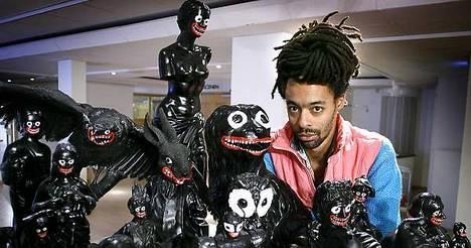
The purpose of this performance was to highlight the issue of female genital mutilation. It was lurid, and many critics thought it trivialized the plight of these young women, something I agree with. The piece was disturbing and problematic, but it was also confrontational. The cake was set up in an art gallery, and there are many pictures of well appointed white folk laughing at the horrific spectacle. I go back and forth about whether this work is the ultimate trollery or a multilayered thought-provoking piece.
I have checked out Linde’s other work, and it uses grotesque images of black faces and juxtaposes them in European settings. In one, Queen Elizabeth (the current one) stands next to a man defaced with Golliwog-like features. The same face appears on the head of a classical Greek statue. What draws me in also chases me away. Here, Linde’s work is more slightly nuanced. It is still very unsettling and has the subtlety of a Julie Traymor production.
I play with black grotesques and archetypes in my own work; I think what I do with them is less ambiguous than Linde’s work. For instance, my story “Catch Him By The Toe” riffs on the Sambo story. These horrible images, archetypes, tropes and stories are a part of our heritage. If the fashion industry can use them, we have a right to use them as well.


May 27, 2013
Muses: Arthur Rimbaud, Cosmic Vagabond
Arthur Rimbaud’s brief meteoric rise and fall as poet is the stuff of legend. His writing career spanned five years and ended abruptly at 21.
His poems are more like incantations. Violent, mystical, always transforming itself–he thought words were like alchemical formulas. Poems were portals to both Heaven, Hell and all between. He created a new alphabet that reflected hidden energy of language. Illuminations, his final work, eschewed poetic form; they are prose poems full of sacred and profane images in an opiated language that hints of an otherworld.


May 22, 2013
New review of Bereft
Critic Amos Lassen says of Bereft,
There is no happy ending here and I doubt there ever will be if we do not live up to our responsibilities to make the world a better place for everyone. I suspect that there is a lot of the author’s own life here but even if there is not, I believe we can all agree that we do not yet live in a world that is free of racism and homophobia. It is surprising that we have to be reminded of that. If we do have to be reminded, I am glad that it is Craig Gidney’s powerful and beautiful prose.



